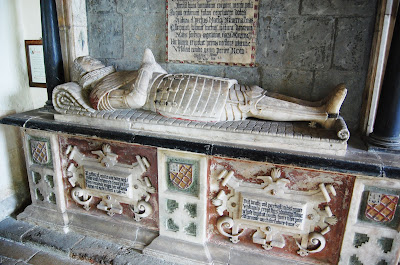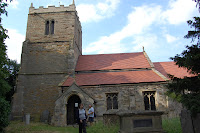First to Sempringham, in Lincolnshire, which once had a priory, the home of the English Saint Gilbert and his Order of Gilbertines. That association was the reason for our visit there in August 2011. The last thing we expected to see was a memorial to Gwenllian, the last Princess of Wales, who died in 1337.
Of course, we wanted to know the story behind this oddity. In 1282 King Edward I defeated and killed Gwenllian's father, the Prince of Wales Llewellyn ap Gruffydd, and so she stood to inherit the crown of Gwynnedd, as she had no brothers. In an act of political calculation, to head off future allegiances from her compatriots, Edward moved her away from her homeland to Sempringham, a remote location at the edge of the Lincolnshire fens. The Priory was later given £20 a year to care for her for what turned out to be 54 years. Gwenllian was in fact distantly related to Edward through an illegitimate line from King John. During her lifetime, the title of Prince of Wales was appropriated by the British crown and first given to Edward II (who was born in Caernarfon). Nonetheless, pilgrims now come to visit her memorial, which was erected in the 1990's.
If this was an unexpected find of historical significance, the memorial to William Cecil, first Baron Burghley, was entirely what we might have expected of Queen Elizabeth I's Secretary of State from 1558 and Lord High Treasurer from 1572 to his death in 1598. His alabaster and marble tomb in St Martin's church in Stamford is a magnificent object.

He was born in Bourne in Lincolnshire in 1520 and completed Burghley House in 1587 on land just outside Stamford that he inherited from his father. His dynasty includes the Earls of Exeter and Salisbury. Memorials to some of his descendants are included in the Burghley Chapel in St Martins.
Also included in the Chapel is a plaque to the memory of Benjamin Disraeli, which reads:
Late Prime Minister. The intrepid leader of the Conservative Party, the patriotic servant of his country and a true and valued friend at Burghley House. Born Dec 21, 1804. Died April 19 1881. Peace with Honour.
Alabaster monuments have a particular importance in the East Midlands, as the main source of supply of alabaster in the middle ages was Nottinghamshire, Derbyshire and Staffordshire. In fact, Nottingham was famous across Europe as a centre for alabaster carving. This may explain why we have seen so many. While few are as lavish as Willaim Cecil's, some run him close and allow us to appreciate alabaster as a material in its natural, unadorned state.
The monument to Charles Noel in St Peter's, Brooke in Rutland is particularly fine, although it is the tomb itself rather than the effigy that retains its original paintwork. Charles, who died in 1619 at the age of 28, was the second son of Andrew Noel, courtier to Elizabeth I and the builder of the family mansion at Brooke. Charles was unmarried but the family were ancestors to future Earls of Gainsborough and Viscounts Campden. They acquired Exton Hall through marriage and the church there, just across Rutland Water, houses further very fine monuments, one of which can be seen in our post on Celebrity Churchcrawlers of 7 March 2012.The monument to Richard Whalley of Screveton, in Nottinghamshire, who died in 1583, was mentioned in the previous post. It is worth another photo just to show off the fine alabaster and appreciate the joke in having a whale as the family emblem. A whale adorns the head and foot of the effigy and that at the foot is quite naturalistic, despite looking more like a fish than a whale! Although Richard had 25 children with 3 wives, a plaque on the memorial indicates that the family died out in 1690.
The grandest monuments tend to be to the very rich. One of the richest was Sir Gilbert Heathcote, from a Derbyshire family in the 17th Century, who made his fortune as a London merchant and became both the Lord Mayor of London and the Governor of the Bank of England. He invested his wealth in buying an estate in Rutland and lived out his days there in Normanton Hall, later the home of his descendants, the Earls of Ancaster. In the 1970s, the village and site of the Hall, gutted by fire in 1925, were covered by Rutland Water, although the stable block survives as the Normanton Hall hotel. The top of Normanton's Georgian church of St Matthew can still be seen at the water's edge, serving as a museum. Sir Gilbert's memorial is in the St. Mary the Virgin church at nearby Edith Weston.
George Bass went to school in Boston, was admitted to the Company of Surgeons in London at the age of 18 and joined the Royal Navy in 1794. While his career was illustrious, he died in mysterious circumstances, setting off from Sydney in 1803 for Tahiti and Chile, never to be seen again.
Finally, the memorial to Mary Lister, who died in 1734 in Coleby, Lincolnshire, provides an insight into the social conventions of the 18th Century, especially the place of women. Memorials to women, other than as wives in family tombs, are quite rare. Mary Lister was from a landed family and funds were clearly availble to record for posterity that she was:
A woman of very good sense,The churches in which these monuments can be seen are shown below. Click on any picture to enlarge it.
Submissive and condescending to her superiors,
Affable and courteous to her equals,
Easy and humourous to her inferiors,
Agreeable and obliging to all.
 |
| Coleby |
Screveton
Edith Weston
 |
| St Martin, Stamford |
 |
| Brooke |
 |
| Sempringham
*Remembered Lives: Personal Memorials in Churches, by David Meara and Lida Cardozo Kindersley, Cambridge University Press, January 2013
|
|









No comments:
Post a Comment